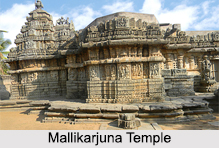 Sculpture of Mallikarjuna Temple has been done on the Chalukyan idiom. In an inscription an alternative name for the temple has been suggested: Sri Trailokeswara Maha Saila Prasada. It was built around 740 AD with the aim of celebrating the victory of Vikramaditya II (733-45 A.D.) over the Pallavas.
Sculpture of Mallikarjuna Temple has been done on the Chalukyan idiom. In an inscription an alternative name for the temple has been suggested: Sri Trailokeswara Maha Saila Prasada. It was built around 740 AD with the aim of celebrating the victory of Vikramaditya II (733-45 A.D.) over the Pallavas.
Features of Mallikarjuna Temple Sculpture
The architecture of Mallikarjuna Temple, to a large extent, is similar to that of Virupaksha temple. This temple has been built in the southern vimana style. The architectural features of this temple include `garbhagriha,` an antechamber, pradakshina patha, a sub-shrine, a sabha-mandapa with entrance verandahs on east, north and south directions and a Nandi-mandapa in front of the Mallikarjuna Temple.
Eroticism is a part of the temple sculpture. The basement of the temple has been beautifully carved with sculpted elephants while the outer walls are designed with female figures that are to be found on their niches. The attractive arrangement of the walls of the shrines and the mandapa (hall) is with two eaves that run about the temple. The first deep eaves run under the superstructure and all around the temple with a shelf of about short a meter. The second eaves run around the temple about a meter below the first. Between the two eaves are the small attractive towers on pilasters. Below the second eaves are the wall panel of images of Hindu deities and their assistants in reinforcement.
The sub-shrines are dedicated to Lord Ganesha and Mahisasuramardhini. The gateway and the pillars of the temple still exist. The entire temple is built on a raised stone platform. The recesses on the outer walls of the temple have been designed with carved images. In addition to this the image of a Nataraja is to be found in the arch of the sukanasa of this temple.
Different Works of Mallikarjuna Temple Sculpture
Prominent works among the wall panel sculptures and portraying scenes from the epics and Puranas are the 16-handed Shiva dancing on the head of a demon called Andhakasura, dancing images of a 22-armed Durga and Saraswati, King Ravana lifting Mount Kailash, the Pandava prince Arjuna shooting the fish target and Draupadi rushing onwards with garland and the slaying of the evil spirit Gajasura. On the pillars of the sabha-mandapa the images of goddesses fighting with Mahisasura, Narasimha fighting Hiranyakasipu, slaying of Maricha, churning of the ocean or `samudra-manthana` and others have been depicted.



